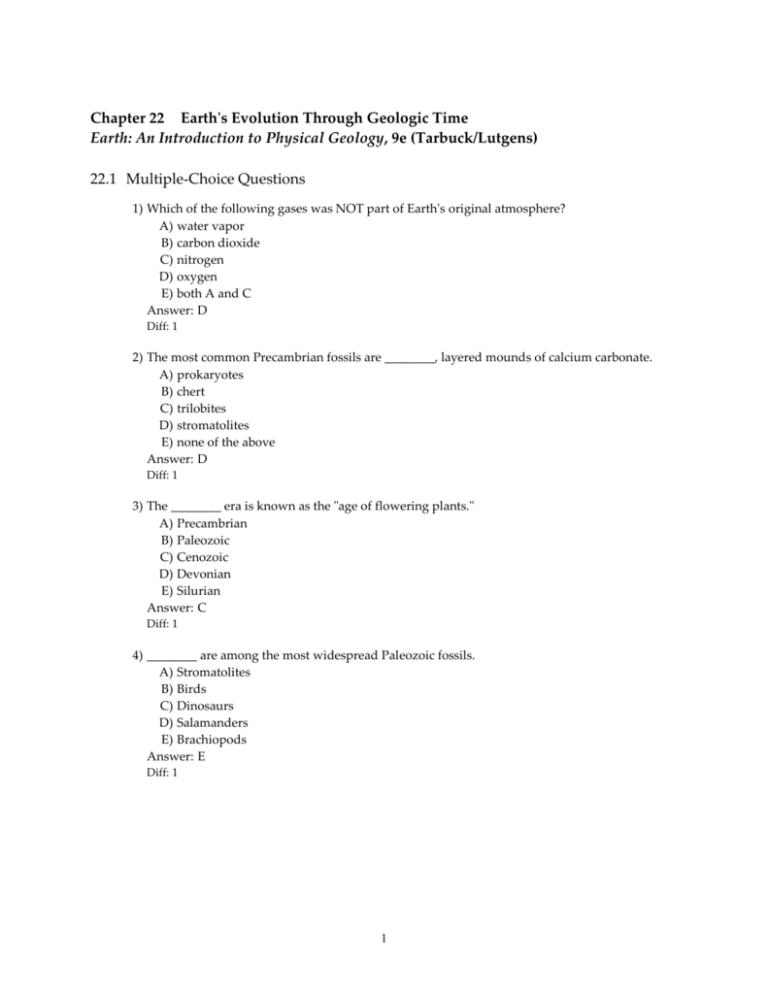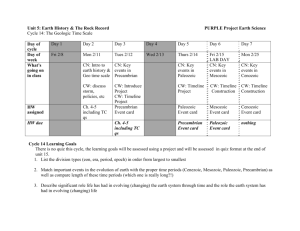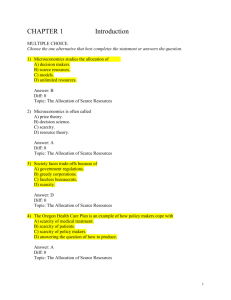Earth,Tests,Ch22
advertisement

Chapter 22 Earth's Evolution Through Geologic Time Earth: An Introduction to Physical Geology, 9e (Tarbuck/Lutgens) 22.1 Multiple-Choice Questions 1) Which of the following gases was NOT part of Earth's original atmosphere? A) water vapor B) carbon dioxide C) nitrogen D) oxygen E) both A and C Answer: D Diff: 1 2) The most common Precambrian fossils are ________, layered mounds of calcium carbonate. A) prokaryotes B) chert C) trilobites D) stromatolites E) none of the above Answer: D Diff: 1 3) The ________ era is known as the "age of flowering plants." A) Precambrian B) Paleozoic C) Cenozoic D) Devonian E) Silurian Answer: C Diff: 1 4) ________ are among the most widespread Paleozoic fossils. A) Stromatolites B) Birds C) Dinosaurs D) Salamanders E) Brachiopods Answer: E Diff: 1 1 5) As the solar system began forming, the first materials to condense into small particles were ________ and nickel. A) oxygen B) silicon C) nitrogen D) carbon E) none of the above Answer: E Diff: 1 6) Which one of the following represents the greatest expanse of geological time? A) Mesozoic B) Cenozoic C) Precambrian D) Paleozoic Answer: C Diff: 1 7) During the early Paleozoic era, the current continents of South America, Africa, Australia, Antarctica, India, and perhaps China comprised the vast southern continent of ________. A) Europe B) Laurasia C) Gondwanaland D) Antindia E) Pangaea Answer: C Diff: 1 8) Which type of bacteria thrives in environments that lack free oxygen? A) aerobic B) placental C) anaerobic D) foraminifera E) photosynthetic Answer: C Diff: 1 9) Which era of geologic time spans about 88% of Earth's history? A) Precambrian B) Paleozoic C) Mesozoic D) Cenozoic E) none of the above Answer: A Diff: 1 2 10) The ________ means "the sun in the making." A) solar disk B) presun C) nebular sun D) sol E) protosun Answer: E Diff: 1 11) Mammals became the dominant land animals during the ________ era. A) Pleistocene B) Cenozoic C) Cretaceous D) Mesozoic E) Paleozoic Answer: B Diff: 1 12) The ________ period was a time of major extinctions, including 75 percent of amphibian families. A) Jurassic B) Mississippian C) Permian D) Pennsylvanian E) Devonian Answer: C Diff: 1 13) The beginning of the Cambrian Period marks an important event in animal evolution — the appearance of organisms with ________. A) wings B) cells C) hard parts D) vertebrae E) none of the above Answer: C Diff: 1 14) The era of "ancient life" is the ________ era. A) Cenozoic B) Precambrian C) Neolithic D) Mesozoic E) none of the above Answer: E Diff: 1 3 15) Due to a virtual absence of land plants and certain animals, fossil fuels are notably absent in ________ rocks. A) Precambrian B) Paleozoic C) Mesozoic D) Cenozoic E) Paleozoic and Mesozoic Answer: A Diff: 1 16) The major source of free oxygen in the atmosphere is from ________. A) molten rock B) water C) green plants D) silicate minerals E) glaciers Answer: C Diff: 1 17) The age of Earth is about ________. A) 2 billion years B) 4.5 million years C) 16 million years D) 4.5 billion years E) 195 million years Answer: D Diff: 1 18) The Precambrian rock record indicates that much of Earth's first free oxygen combined with ________ dissolved in water. A) potassium B) silicon C) iron D) carbon E) none of the above Answer: C Diff: 1 19) Which one of the following does NOT characterize the early development and specialization of the primitive mammals? A) increase in size B) increase in stomach capacity C) increase in brain capacity D) specialization of limbs E) specialization of teeth Answer: B Diff: 1 4 20) As they formed, due to their high temperatures and comparatively weak gravitational fields, which planets were unable to retain appreciable amounts of hydrogen, helium, and ammonia? A) Jupiter and Neptune B) Mercury and Earth C) Uranus and Pluto D) Jupiter and Uranus E) Neptune and Uranus Answer: B Diff: 1 21) Abundant fossil evidence did not appear in the geologic record until about ________. A) 5 billion years ago B) 6 million years ago C) 550 million years ago D) 300 million years ago E) 3 billion years ago Answer: C Diff: 1 22) During the late Paleozoic, the present-day North America, Europe, western Asia, Siberia, and perhaps China formed the northern continent of ________. A) Gondwanaland B) Laurasia C) Greenland D) Africa E) none of the above Answer: B Diff: 1 23) Most ________ rocks are devoid of fossils, which hinders correlation of rocks. A) Precambrian B) Paleozoic C) Mesozoic D) Cenozoic E) Mesozoic and Cenozoic Answer: A Diff: 1 24) The ________ period is sometimes called the "golden age of trilobites." A) Cambrian B) Silurian C) Pennsylvanian D) Devonian E) Triassic Answer: A Diff: 1 5 25) ________ means "planets in the making." A) Jovian B) Asteroids C) Terrestrial D) Protoplanets E) none of the above Answer: D Diff: 1 26) The process in which plants use light energy to synthesize food sugars from carbon dioxide is called ________. A) photosynthesis B) hydration C) oxidation D) fusion E) none of the above Answer: A Diff: 1 27) The beginning of the ________ era is marked by the appearance of the first life forms with hard parts. A) Precambrian B) Paleozoic C) Mesozoic D) Cenozoic Answer: B Diff: 1 28) Each continent contains large "core areas" of Precambrian rocks referred to as ________. A) rifts B) plates C) plateaus D) shields E) none of the above Answer: D Diff: 1 29) By the close of the Paleozoic, all the continents had fused into the single super continent of ________. A) Laurasia B) Pangaea C) Appalachia D) Gondwanaland E) Europa Answer: B Diff: 1 6 30) Earth's primitive atmosphere evolved from gases ________. A) produced by radioactive decay B) collected from the nebula C) escaping from water D) from the sun E) expelled from within Answer: E Diff: 1 31) The most economically important resource in Cenozoic strata of the Gulf Coast is ________. A) petroleum B) carbon C) coal D) fresh water E) iron Answer: A Diff: 1 32) The waste gas released by plants as they synthesize food sugars from carbon dioxide and water is ________. A) oxygen B) methane C) nitrogen D) carbon dioxide E) none of the above Answer: A Diff: 1 33) Most of Earth's iron ore occurs in middle ________ rocks. A) Precambrian B) Paleozoic C) Mesozoic D) Cenozoic Answer: A Diff: 1 34) The first true terrestrial animals were the ________. A) mammals B) reptiles C) lobe-finned fish D) trilobites E) marsupials Answer: B Diff: 1 7 35) This least understood era of Earth's history has not been subdivided into briefer time units. A) Precambrian B) Paleozoic C) Mesozoic D) Cenozoic Answer: A Diff: 1 36) During the ________ Period, large evaporite deposits of rock salt and gypsum formed in North America. A) Cambrian B) Silurian C) Pennsylvanian D) Jurassic E) Tertiary Answer: B Diff: 1 37) The supercontinent of Pangaea began to breakup during the ________ Era. A) Precambrian B) Paleozoic C) Mesozoic D) Cenozoic Answer: C Diff: 1 38) Which era is sometimes called the "age of dinosaurs"? A) Pleistocene B) Cenozoic C) Cretaceous D) Mesozoic E) none of the above Answer: D Diff: 1 39) During the ________ Era, the westward-moving North American plate began to override the Pacific plate, eventually causing the tectonic activity that ultimately formed the mountains of western North America. A) Precambrian B) Paleozoic C) Mesozoic D) Cenozoic E) none of the above Answer: C Diff: 1 8 40) By the ________ period, large tropical swamps extended across North America, eventually becoming the vast coal deposits of today. A) Cambrian B) Silurian C) Pennsylvanian D) Devonian E) Triassic Answer: C Diff: 1 41) One group of reptiles, exemplified by the fossil Archaeopteryx, led to the evolution of ________. A) dinosaurs B) mammals C) cephalopods D) birds E) horses Answer: D Diff: 1 42) Which period is known as the "age of fishes"? A) Jurassic B) Mississippian C) Permian D) Pennsylvanian E) Devonian Answer: E Diff: 1 43) During the Cenozoic, plate interactions gave rise to many events of mountain building, volcanism, and earthquakes in ________ North America. A) western B) central C) eastern D) southern E) northern Answer: A Diff: 1 44) The cells of these primitive organisms lack organized nuclei and they reproduce asexually. A) trilobites B) eukaryotes C) prokaryotes D) brachiopods E) none of the above Answer: C Diff: 1 9 45) Following the reptilian extinctions at the close of the Mesozoic, two groups of mammals, the marsupials and ________, evolved. A) eukaryotes B) cephalopods C) trilobites D) placentals E) stromatolites Answer: D Diff: 1 46) The theory for the origin of the solar system is known as the ________ hypothesis. A) Big Bang B) nebular C) terrestrial D) solar E) none of the above Answer: B Diff: 1 22.2 Word Analysis Questions Examine the words and/or phrases for each question below and determine the relationship among the majority of words/phrases. Choose the option which does not fit the pattern. 1) A) Paleozoic B) Precambrian C) Mesozoic D) Cenozoic Answer: Precambrian Diff: 1 2) A) protoplanet B) planetesimal Answer: supercontinent C) supercontinent D) protosun C) Rodinia D) Gondwana B) outgasssing C) water vapor D) carbon dioxide B) reptiles C) gymnosperms D) dinosaurs Diff: 1 3) A) Pangaea B) North America Answer: North America Diff: 1 4) A) oxygen Answer: oxygen Diff: 2 5) A) mammals Answer: mammals Diff: 2 10 22.3 True/False Questions 1) The decay of radioactive atoms, coupled with heat released by colliding particles, produced at least some melting of Earth's early interior. Answer: TRUE Diff: 1 2) We are now living in the Mesozoic era. Answer: FALSE Diff: 1 3) Most Mesozoic rocks are devoid of fossils, consequently this is the least understood span of Earth's history. Answer: FALSE Diff: 1 4) Probably the single most characteristic feature of the Precambrian is its great abundance of fossil evidence. Answer: FALSE Diff: 1 5) Due to differentiation, the lighter, gaseous materials escaped Earth's interior and became the primitive atmosphere. Answer: TRUE Diff: 1 6) During the early Paleozoic Era, the continent of Gondwanaland included North and South America. Answer: FALSE Diff: 1 7) The bodies of our solar system began forming about 5 billion years ago from an enormous cloud of minute rocky fragments and gases. Answer: TRUE Diff: 1 8) The first true terrestrial land animals were the mammals. Answer: FALSE Diff: 1 9) Earth's original atmosphere, several billion years ago, was similar to the present atmosphere. Answer: FALSE Diff: 1 10) The Cenozoic Era is the age of mammals. Answer: TRUE Diff: 1 11 11) The major source of oxygen in Earth's atmosphere is from the decay of plants. Answer: FALSE Diff: 1 12) The supercontinent of Pangaea formed during the late Mesozoic Era. Answer: FALSE Diff: 1 13) Much of the original free oxygen in the atmosphere combined with iron dissolved in water to become iron oxide. Answer: TRUE Diff: 1 14) With the perfection of the shelled egg, reptiles quickly became the dominant land animals of the Mesozoic Era. Answer: TRUE Diff: 1 15) Because of their high surface temperatures and comparatively weak gravitational fields, during their formation, the inner planets retained appreciable amounts of hydrogen, helium, and ammonia as part of their composition. Answer: FALSE Diff: 1 16) During the Cenozoic Era, the eastern and western margins of North America experienced similar geologic events. Answer: FALSE Diff: 1 17) Altered climatic conditions at the end of the Paleozoic Era caused one of the most dramatic biological declines in all Earth history. Answer: TRUE Diff: 1 18) Evidence indicates that some dinosaurs were warm blooded. Answer: TRUE Diff: 1 19) The large outer planets (Jupiter, Saturn, Uranus, and Neptune) contain huge amounts of hydrogen and other light materials as part of their composition. Answer: TRUE Diff: 1 20) Fossil fuels are abundant in Precambrian rocks. Answer: FALSE Diff: 1 21) A major event of the Mesozoic Era was the breakup of the supercontinent called Pangaea. Answer: TRUE Diff: 1 12 22) The fault-block mountains of Nevada and Mexico formed during the Cenozoic Era. Answer: TRUE Diff: 1 23) When Earth's primitive surface cooled below water's boiling point, torrential rains slowly filled low areas, forming oceans. Answer: TRUE Diff: 1 24) Volcanic activity was common in the West during much of Cenozoic time. Answer: TRUE Diff: 1 25) The earliest land plants had large, broad leafs to efficiently intercept sunlight. Answer: FALSE Diff: 1 26) Mammals replaced reptiles as the dominant land animals in the Cenozoic Era. Answer: TRUE Diff: 1 27) Well preserved remains of many tiny organisms extend the record of life back beyond 5 billion years. Answer: FALSE Diff: 1 28) A wave of late Pleistocene extinctions rapidly eliminated many large mammals. Answer: TRUE Diff: 1 29) The fossil record supports the hypothesis that the hard parts of organisms evolved for survival. Answer: FALSE Diff: 1 30) The evolution of both birds and mammals was strongly influenced by the development of flowering plants. Answer: TRUE Diff: 1 31) The beginning of the Precambrian Era is marked by the appearance of the first life forms with hard parts. Answer: FALSE Diff: 1 32) Many reptile groups became extinct at the close of the Cenozoic Era. Answer: FALSE Diff: 1 13 33) During the Cenozoic Era, a great wedge of sediments from the eroding Rockies created the Great Plains. Answer: TRUE Diff: 1 34) Evidence of an extensive glaciation places western Africa near the South Pole during the early Paleozoic Era. Answer: TRUE Diff: 1 22.4 Short Answer Questions 1) Bacteria that thrive in oxygen free environments are called ________ bacteria. Answer: anaerobic Diff: 1 2) The theory for the formation of the solar system is known as the ________. Answer: nebular hypothesis Diff: 1 3) During the early Paleozoic Era, the ________ orogeny affected eastern North America from the present-day central Appalachians to Newfoundland. Answer: Taconic Diff: 1 4) What were the three gases that made up Earth's original atmosphere? ________, ________, ________ Answer: water vapor, carbon dioxide, nitrogen Diff: 1 5) The rock formations of the ________ Era are more widespread and less disturbed than those of any other time. Answer: Cenozoic Diff: 1 6) During the process of ________, plants release the gas ________. Answer: photosynthesis, oxygen Diff: 1 7) By the late ________ Period, true air-breathing amphibians with fish-like heads and tails had evolved. Answer: Devonian Diff: 1 8) The ________ Era spans about 88% of Earth's history. Answer: Precambrian Diff: 1 14 9) The most economically important resource in Cenozoic strata of the Gulf Coast is ________. Answer: petroleum (natural gas) Diff: 1 10) Planets in the making are referred to as ________. Answer: protoplanets Diff: 1 11) The most common Precambrian rock type is ________ rock. Answer: metamorphic Diff: 1 12) The Cenozoic Era is often called the "age of ________." Answer: mammals Diff: 1 13) On continents, large "core areas" of Precambrian rocks, called ________, dominate the surface. Answer: shields Diff: 1 14) The ________ Period was the "golden age of trilobites." Answer: Cambrian Diff: 1 15) The time of the great extinction that took place at the end of the Mesozoic Era is called the ________ or KT boundary. Answer: Cretaceous-Tertiary Diff: 1 16) The sun in the making is known as the ________. Answer: protosun Diff: 1 17) Western North America is the leading edge of the ________ plate. Answer: North American Diff: 1 18) Extensive deposits of ________ ore are found worldwide in Precambrian rocks. Answer: iron Diff: 1 19) In North America (including Greenland), the vast exposure of Precambrian rocks, called the ________ Shield, encompasses 2.8 million square miles. Answer: Canadian Diff: 1 15 20) The development of ________, organisms that reproduce sexually and have cells that contain nuclei, may have increased dramatically the rate of evolutionary change. Answer: eukaryotes Diff: 1 21) Human evolution takes place during the ________ Period of the ________ Era. Answer: Quaternary; Cenozoic Diff: 1 22) Fossils that are not of the animals themselves, but of their activities, such as trails and wormholes, are referred to as ________ fossils. Answer: trace Diff: 1 23) The ________ were the dominant trees of the Mesozoic Era. Answer: gymnosperms Diff: 1 24) Following the reptilian extinctions at the close of the Mesozoic Era, two groups of mammals, the marsupials and ________, evolved and expanded. Answer: placentals Diff: 1 25) Many of the most ancient fossils are found in a hard, dense, chemical rock called ________. Answer: chert Diff: 1 26) The late ________ Era extinction was the greatest of at least five mass extinctions to occur over the past 600 million years. Answer: Paleozoic Diff: 1 27) ________ are the dominant land plants of the Cenozoic Era. Answer: Angiosperms Diff: 1 28) Primitive organisms, called ________, reproduce asexually and contain cells that lack organized nuclei. Answer: prokaryotes Diff: 1 29) Toward the end of the Mesozoic Era, the ________ orogeny formed the southern ranges of the Rocky Mountains. Answer: Laramide Diff: 1 30) One hypothesis for the extinction that took place at the end of the Mesozoic is that a large ________ collided with Earth. Answer: asteroid Diff: 1 16 22.5 Critical Thinking Questions Use complete sentences, correct spelling, and the information presented in Chapter 22 to answer the questions below. 1) Briefly discuss the development of life in the Paleozoic as compared to the Mesozoic. Diff: 2 2) How does the supercontinent cycle fit into the entire scheme of plate tectonics? Also, how does the cycle help explain the origin of cratons? Diff: 3 3) Discuss how Earth's early atmosphere is thought to have formed. What role did bacteria play in the development of our modern atmosphere? Diff: 2 17









